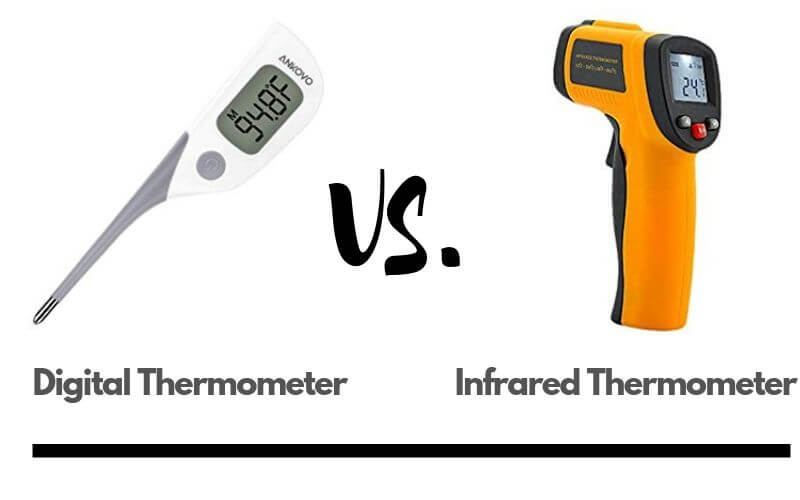Thermometers have gone through a lot of changes over the years. At first, mercury thermometers were the holy grail for a large chunk of the population.
Then the digital thermometer took the oldies place because it was something innovative. Eventually, even they phased out and were soon enough replaced with the non-contact infrared Thermometers.
One group of people missed their old digital ones and shifted back, while the other liked the IR one better and stuck to it.
We don’t want you to go through the same dilemma. That’s why we are presenting you with a head-to-head comparison of the two types of devices.
But before we get into the comparison section, let’s know a bit more about them.
Digital Thermometer
It is an instrument that can measure temperature and the result would be shown as a numerical reading on the screen. Meaning, the exact temperature of the object measured. The value shows up in decimal points making reading easier and precise.
Infrared Thermometer
This is a device that takes in the radiation emitted by the object and calculates its temperature. They are known as non-contact Thermometers and laser thermometers. An infrared thermometer uses the formula of characteristic radiation. The matter that has a temperature above absolute zero (0 K) always emits radiation relative to its temperature and this unique characteristic of every matter is known as characteristic radiation. An infrared thermometer detects the emissivity of an object and the amount of radiation energy emitted by that object to measure its temperature.
Infrared Thermometer Vs Digital Thermometer – Head to Head Comparison
Each of these instruments has its pros and cons. While one is ideal for one thing and unsuitable for the other. That’s why below we are going to compare their features so that you can easily choose between them.
Mode of Using
In this section, we are going to discuss the mode of use for both devices.
- IR
Infrared Thermometers measure the temperature from a distance as they have the ability to absorb the radiation emitting from the item’s body. They also have a laser, which releases a beam of laser, and one can point it towards the desired location. It is specific.
- Digital
Digital Thermometers are known as contact thermometers. As its name suggests, one has to bring the device into contact with the object or person to have a reading.
One can use this type of instrument in three ways:
- Inserting it inside the mouth (Orally)
- Putting the probe inside the bottom (Rectal)
- Placing the equipment under one’s arm (Axillary)
Accuracy
Let’s talk about the accuracy of both devices.
- IR
The IR Thermometer Gun is a comfortable, consistent, and very precise equipment for measuring a change in temperatures. A better result would be obtained if the distance between the instrument and the object is smaller and if the laser is pointing towards the desired spot.
A problem, however, with this one arises if the beam isn’t aimed correctly or the distance is too great.
You see, the device detects the radiation from the surface of the product’s body, and with a bigger distance and a poor aim, the result would become compromised. This is because the equipment would start taking in the radiation from the surrounding area of the item.
Ranging from 0 to 600 Fahrenheit, the IR thermometer has an accuracy of about ±3.5 Fahrenheit. (Reference: https://health.clevelandclinic.org/are-infrared-thermometers-accurate/)
When using a digital thermometer, you could use it in three different ways as mentioned above. The accuracy of each of these differs from one another.
- Digital
Rectal checking is far more reliable and accurate than any of them. It detects your actual core temperature as it is inserted inside your body. The least accurate method is by placing it under the arm because it is not in touch with the core parts of the body.
Oral insertion is right in the middle. It is more accurate than the axillary method as you place the probe inside your mouth. But it is not more precise than the rectal one, as the core temperature slightly has a different temperature from the mouth of an organism.
Applications
Here we are going to talk about the applications of both the device.
- Digital
Because the digital thermometer can give out readings in decimal places, it’s an excellent instrument to be used in fluid mediums. For example, with this device, you can see if the temperature is right for a baby to bathe in.
It can also be used to check and monitor body temperature.
- IR
This mainly focuses on industrial purposes such as testing to see whether or not there are any hot spots in the cooling panel, or if the duct has any leakage.
It can also be used in agriculture and food safety purposes such as checking to see if the surrounding temperature is suitable for the growth of vegetables. It helps the farmers to maximize their profit.
Humans can also use this to find out their body temperature. However, you need to be a bit careful with the device as you don’t want to point the laser at your eyes.
Safety
Let’s talk about how safe both the devices are.
- Digital
One thing is common to see among those who share a thermometer is that they usually transmit the disease between one other. This often happens when the probe isn’t properly cleaned after being used. Pathogens are able to move from one body to another easily like this.
So, you have to be sure that the equipment is sanitized with antibacterial after every use.
- IR
Since it has infrared radiation and laser involved here, it can cause severe eye and skin irritation if it hits the eye. If a powerful laser is used there is a possibility that the person might go blind due to the beam touching the eyeballs.
Final Words
There is no “the best” one here. Two groups are present; one would say the digital one is better while the other would opt for the IR instrument without a second thought.
This really comes down to one’s preferences and how one is comfortable using the equipment. Good or bad, it’s all up to you to decide what’s right for you.
So, which one do YOU think is better? Let us know in the comment section below and tell us why you think so.
Have fun choosing, Ciao.

